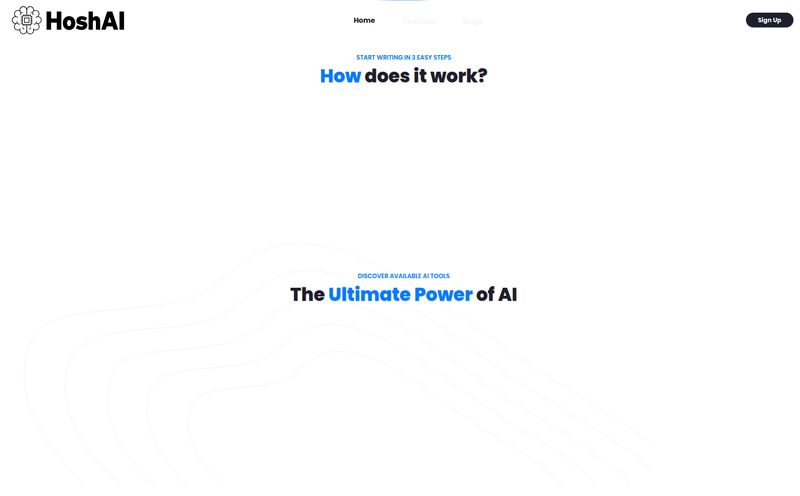Alright, let’s talk. As someone who’s been in the trenches of digital marketing for years, I've seen my fair share of 'game-changing' tools. You know the ones. They promise to automate the grind, generate leads while you sleep, and basically print money. My inbox is a graveyard of these promises. So when I heard about TomBot, a growth hacking service for X (the platform we all still stubbornly call Twitter), my interest was piqued. An automated fleet of bots for social selling on X? Sounds pretty slick.
The idea of automating Sales Development Representative (SDR) tasks on a platform as noisy as X is, frankly, appealing. The manual process is a slog. Finding the right people, engaging in a non-creepy way, building lists... it can eat up your entire day. But then I went to check out the tool, and things got... weird. The journey to understanding TomBot turned into less of a product review and more of an internet mystery. And honestly? That makes it even more interesting to talk about.
So, What Exactly is TomBot Supposed to Be?
On paper, TomBot sounds like a dream for B2B marketers, solopreneurs, and anyone trying to build a brand on X. The core concept is an AI-powered service that uses automated 'growth bots' to handle your social outreach and lead generation. It’s built on the idea of conversational marketing. Instead of just blasting links into the void, it’s designed to start conversations, nurture connections, and warm up potential leads for you.
Think of it as hiring a team of tireless digital assistants. Their only job is to scour X, find people talking about topics relevant to your business, and engage them in a natural way. It’s meant to take the most repetitive, time-sucking parts of social selling off your plate so you can focus on closing the deals it brings in. A pretty compelling pitch, right?
The Promised Land: Breaking Down TomBot’s Features
So what's under the hood? Based on the information I could dig up, TomBot's arsenal is focused and direct. It’s not trying to be an all-in-one social media scheduler. It’s a specialist.
The main features seem to revolve around a few key activities. First, automated social outreach. This is the engine of the whole thing. The bots would presumably handle the initial contact, liking relevant posts, and sending opening DMs or replies. Then there’s automatic list building and hashtag targeting. You’d tell the bot to follow everyone using #SEO or #GrowthHacking, and it would build a prospect list from that. It’s a classic strategy, just put on autopilot.
But the real interesting part is the promise of automating SDR tasks. That implies a level of sophistication beyond simple auto-DMs. It suggests a system that can handle some back-and-forth, qualify leads based on their responses, and then hand them off to a human. This is the holy grail of sales automation—a system that filters out the noise and only alerts you when a real, warm lead is on the line.

Visit TomBot
The Potential Upside: Why You'd Even Consider a Tool Like This
I get the appeal. I really do. The feast-or-famine cycle of lead generation is real. One week you're drowning in discovery calls, the next you're staring at an empty calendar wondering if you’ll ever make a sale again. A tool that smooths out that curve is worth its weight in gold.
The primary advantage is efficiency. Imagine the sheer volume of outreach one person can do in a day. Now multiply that by five 'growth agents' working 24/7. Your reach explodes. You're starting more conversations, getting in front of more eyeballs, and theoretically, generating leads far more efficiently than any human could. For a small team or a solo founder, that kind of leverage is a superpower. It allows you to punch way above your weight class.
The Big Red Flags and The Spam Question
Okay, let's get to the elephant in the room. Or in this case, the ghost in the machine. As I write this, the domain for TomBot—tombot.ai—is a parked GoDaddy page. They're offering to broker the domain for me. This is... not a great sign. It suggests the service is either defunct, pivoted to a new name, or was never fully launched in the first place. For any SaaS tool, a dead website is a fatal flaw. It screams instability.
Even if the tool were active, there are inherent risks. The line between automated outreach and outright spam is perilously thin. We’ve all gotten those awful, generic LinkedIn messages. If the 'conversational marketing' isn’t impeccably scripted and hyper-personalized, you risk burning your brand’s reputation. Instead of a lead generator, you become a minor annoyance people block on sight.
And then there's the platform risk. Building your entire lead generation engine on a single platform, especially one as volatile as X, is a risky bet. What happens if X changes its API rules overnight? They've done it before. X's automation policy is very specific, and if a tool like this crosses the line, your account could be suspended. Poof. Your entire lead pipeline, gone. It's the digital equivalent of building your house on a seismic fault.
Let's Talk Money: The TomBot Pricing Tiers
Hypothetically, if you could sign up, what would it cost? The pricing structure is tiered, which is standard. It seems to scale based on the number of 'growth agents' and the level of support.
- Conversational Marketing: $250/month for 1 growth agent.
- Lead Generation: $500/month for 3 growth agents.
- Demand Generation: $1000/month for 5 growth agents plus conversion support.
Honestly, the pricing gives me pause. $250 a month for what might be a sophisticated DM bot is reasonable if it works flawlessly. But a thousand dollars a month? For that price, the 'conversion support' better involve a dedicated human expert actively managing your campaigns and writing bespoke scripts. You're entering the territory where you could hire a part-time human virtual assistant. You have to ask: is an automated bot, however smart, better than a real person? I'm not so sure.
My Final Verdict: Should You Hunt Down TomBot?
So, here’s my take. The idea of TomBot is fantastic. It targets a real pain point for marketers and salespeople. The promise of an automated, intelligent SDR for X is incredibly compelling. The features, on paper, are exactly what you'd want from a tool like this.
But the execution? The reality? It seems to be missing in action. Investing time, let alone money, into a service that doesn't have a functional front door is a non-starter for me. The risk is just too high. It's like buying a ticket for a ghost train – the ride sounds thrilling, but you're not entirely sure the train even exists.
If the creators relaunch or if it turns out TomBot lives on under a different name, I'd be first in line to request a demo. But as it stands today, it’s a fascinating concept shrouded in mystery. It serves as a great reminder for all of us in this space: a brilliant idea is worthless without stable, reliable execution. For now, I'll be sticking to the manual grind on X.
Your Questions About TomBot, Answered
What is TomBot?
TomBot is described as an AI-powered growth hacking service designed to automate social outreach, conversational marketing, and lead generation specifically on the X (formerly Twitter) platform.
How does TomBot generate leads on X?
It supposedly uses automated 'growth bots' to perform tasks like targeting users via hashtags, building prospect lists automatically, and initiating conversations through DMs and replies to warm up potential leads.
Is using a tool like TomBot risky?
Yes, there are a few risks. Firstly, poorly managed automation can easily be perceived as spam, which can damage your brand's reputation. Secondly, building your lead generation strategy on a single platform like X is risky, as any changes to X's policies on automation could render the tool useless and even get your account suspended.
How much does TomBot cost?
The proposed pricing had three tiers: $250/month for a basic plan with one 'growth agent', $500/month for three agents, and $1000/month for five agents plus conversion support.
Can I sign up for TomBot right now?
As of this writing, it appears you cannot. The official website domain, tombot.ai, is a parked page on GoDaddy, suggesting the service is not currently active or available to the public.
Conclusion: The Ghost in the Machine
At the end of the day, TomBot is a perfect example of a modern marketing fable. It represents the shiny, alluring promise of AI automation—a world where drudgery is eliminated and results flow effortlessly. But it's also a cautionary tale about the importance of due diligence. A cool concept and a slick feature list mean nothing if the service itself is a ghost. For now, TomBot remains a compelling idea, but not a tool I can recommend anyone actually try to use.
Reference and Sources
- Domain Status: GoDaddy Domain Brokerage for tombot.ai
- Platform Policy: X Automation Rules and Policies



